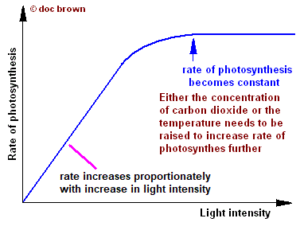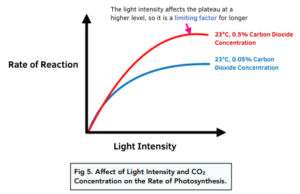Back to: Botany 400 Level
My amazing Afrilearn scholar, welcome back! I hope you’re feeling ready for another exciting lesson today! Have you ever wondered why some plants seem to grow faster in certain places and slower in others? Or why a plant placed in the sun does better than one placed in the shade? The reason behind this is photosynthesis! Today, we’re going to explore the factors that affect photosynthesis, including light intensity, carbon dioxide (CO₂) levels, and temperature. By the end of this lesson, you’ll understand how these factors influence how plants make food.
Factors affecting photosynthesis (light intensity, CO₂, temperature)
Think about how you feel when the sun is shining bright—everything seems better, doesn’t it? You feel more energetic and ready to take on the world. Well, plants feel the same way! Photosynthesis is the process by which plants make their food, and like you, plants rely on certain conditions to do their best. Light, carbon dioxide, and temperature are the three main factors that can affect how well photosynthesis happens in a plant. Just like how you might feel better on a sunny day, plants need the right balance of these factors to thrive and grow strong. Let’s break them down!

Light Intensity
Light intensity is how bright the sunlight is, or how much light the plant is getting. For photosynthesis to occur, plants need light to power the process, but they don’t need an endless amount of it. The right amount of light allows plants to make food effectively.
How it works:
At low light intensity, plants won’t have enough energy to make food, and photosynthesis slows down.
As light intensity increases, photosynthesis speeds up because the plant can capture more light energy.
However, there’s a limit—when light intensity gets too high, photosynthesis levels off because the plant can only handle so much light.
Example:
Imagine trying to read a book in a dimly lit room—it’s hard, right? But when the light is brighter, you can read easily. However, if the light is too bright, it might hurt your eyes or make reading uncomfortable. Plants experience the same thing!
Carbon Dioxide (CO₂)
Carbon dioxide is one of the key ingredients in photosynthesis. It’s like the “fuel” for the plant’s food-making process. The plant takes in CO₂ through tiny openings in its leaves called stomata.
How it works:
More CO₂ in the air means plants can make more food because they have more of the raw material needed for photosynthesis.
If the CO₂ level is too low, photosynthesis slows down. Plants need enough CO₂ to make glucose (sugar) to grow and stay healthy.
Example:
It’s like baking a cake. You need the right ingredients—flour, sugar, eggs, and so on. If you have enough sugar, your cake will turn out perfectly. But if you don’t have enough, the cake won’t rise properly. Plants need enough CO₂ to make their “food,” just like you need the right ingredients to bake a cake.
Temperature
Temperature plays a big role in how fast photosynthesis happens. Like humans, plants have an ideal temperature range for performing their best. If it’s too cold or too hot, photosynthesis slows down.
How it works:
At low temperatures, enzymes (the proteins that help speed up chemical reactions) in the plant move slowly, making photosynthesis less efficient.
At moderate temperatures, the enzymes work at their best, and photosynthesis happens at an optimal rate.
When the temperature becomes too high, enzymes can become damaged, and photosynthesis slows down or stops altogether.

Example:
Think about how you feel when it’s too cold—you might struggle to get moving. When it’s too hot, you might feel drained and tired. Plants are the same! At the right temperature, they’re full of energy and ready to make food. But when it’s too hot or too cold, they can’t work as well.
Consider a tomato plant in your backyard. If it’s placed in a sunny spot with plenty of light, and the temperature is just right (not too hot or cold), and there’s plenty of CO₂ in the air, that tomato plant will thrive and produce a lot of fruit. But if it’s placed in a shaded area, the light intensity will be too low for the plant to photosynthesize properly. If there’s not enough CO₂ in the air, or if the temperature is too high, the plant might stop growing altogether.
In short, for a plant to make the best food, it needs the perfect combination of light, CO₂, and the right temperature, just like you need the right conditions to do your best work.
Summary
Photosynthesis is a process that helps plants make food, and it depends on three main factors:
Light intensity: More light increases photosynthesis, but too much light can harm the plant.
Carbon dioxide (CO₂): Higher levels of CO₂ increase photosynthesis, while low levels slow it down.
Temperature: There’s an ideal temperature range for photosynthesis; too cold or too hot, and photosynthesis slows down.
Evaluation
- How does light intensity affect photosynthesis in plants?
- What happens to photosynthesis when the carbon dioxide level is low?
- Why is temperature important for photosynthesis?
- How would you compare the conditions needed for photosynthesis to conditions needed for human performance?
I’m so proud of you for sticking with your learning and mastering these key concepts! Understanding the factors that affect photosynthesis helps you see how plants grow and thrive. Keep up the hard work, and remember, just like plants need the right conditions to grow, you need the right mindset to succeed. Keep shining, and I can’t wait to see you in the next lesson! Keep growing and learning!
